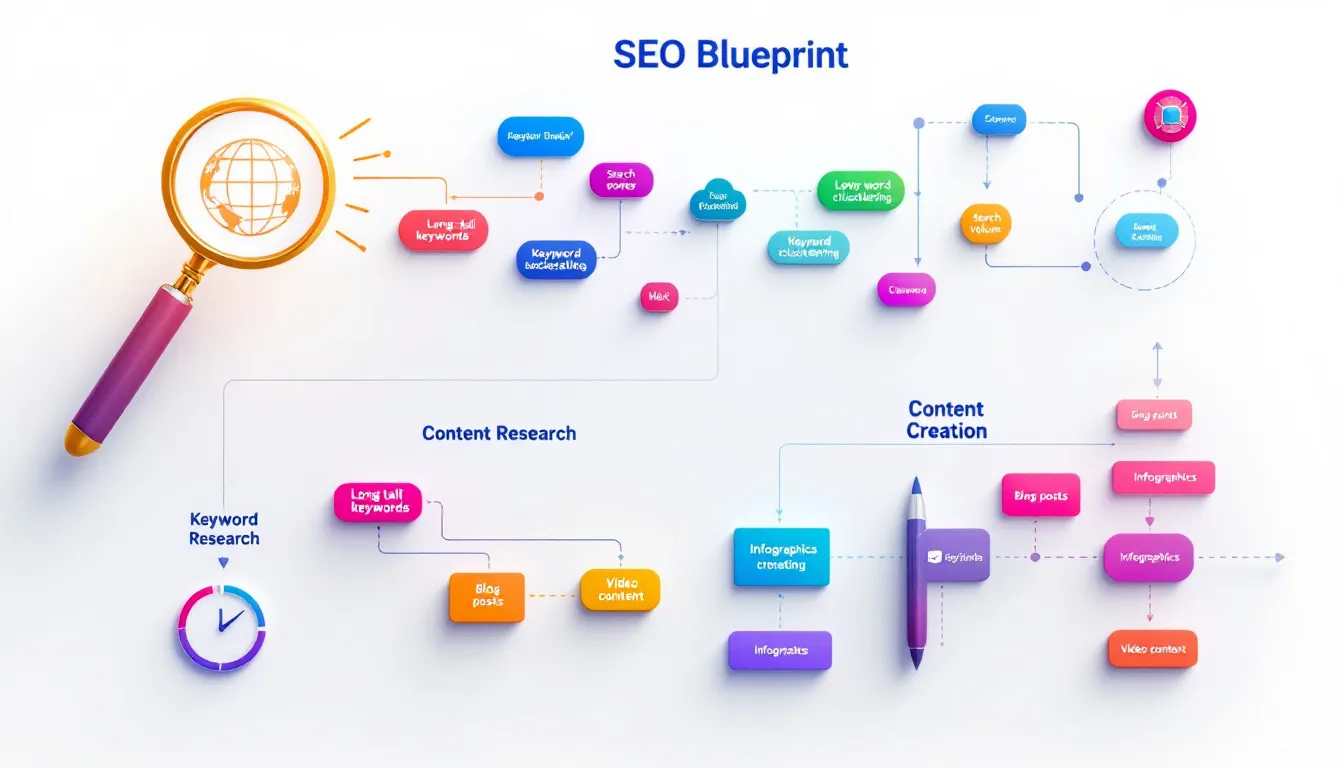SEO : Essential Tips and Best Practices

SEO : Essential Tips and Best Practices
Key Takeaways
Search Engine Optimization (SEO) enhances online visibility and traffic through effective strategies, incorporating on-page, off-page, and technical practices.
Keyword research is fundamental to SEO, guiding content creation by aligning with user search behavior for better visibility and conversion rates.
Improving user experience with mobile-friendly design, fast loading times, and easy navigation is essential for better SEO performance and lower bounce rates.
Understanding SEO Engine Optimization
Search Engine Optimization (SEO) is a crucial method for enhancing a brand’s online presence, leading to higher visibility and traffic. SEO drives quality traffic, enhances user experience, and improves visibility in search results by reaching the right audience through search engine marketing.
Effective SEO strategies help businesses increase brand awareness, online visibility, leads, sales, and customer loyalty.
What is SEO?
SEO, short for Search Engine Optimization, focuses on improving a website’s content, structure, and visibility to rank higher on search engines like Google. The primary benefit of SEO is driving traffic to your website, which is why 49% of marketers consider organic search the highest ROI channel for a search engine optimizer. This is why many seek an engine optimization seo starter guide to understand SEO fundamentals.
SEO plays a pivotal role in increasing traffic and brand visibility by reaching customers at any stage of their journey.
How Search Engines Work
Search engines like Google’s search results operate through processes called crawling and indexing. Crawling involves web and search engines following links to search engines discover new content across the web, which they find by following links from page to page. Once crawled, pages are analyzed and stored in the google search results for future queries, allowing them to appear on google search.
Clear site structure and fresh content make it more likely that crawlers will find all your pages, positively impacting search results and rankings.
Key Components of SEO Engine Optimization
A successful SEO strategy involves a blend of technical, on-page, and off-page practices. Each component plays a vital role in improving a website’s presence in search results. From analyzing keyword competitiveness to engaging in local SEO tactics, understanding these components is crucial for developing a balanced and effective SEO strategy.
On-Page SEO
On-page SEO focuses on optimizing individual web pages to rank higher and earn more relevant traffic. Key elements include page titles, headers, alt text, meta descriptions, and page content. High-quality content helps search engines understand a page’s relevance.
Clear and descriptive file names for images and proper image alt text, along with the name or url path, can enhance SEO performance.
Off-Page SEO
Off-page SEO refers to strategies performed outside of one’s own web pages to improve rankings. Building authority and credibility for a website through link building from relevant, authoritative, and trusted websites is a key focus.
Quality backlinks signal authority to search engines, improving a site’s credibility and search engine rankings.
Technical SEO
Technical SEO ensures that a website meets the technical requirements of search engines. Optimizing site speed, implementing a responsive design, and ensuring clear navigation are crucial aspects.
A logical website structure helps both users and search engines, helping search engines understand and index content efficiently.
Keyword Research for Effective SEO

Keyword research is the backbone of effective SEO. It involves identifying keywords and phrases relevant to your business to ensure visibility through relevant search queries. Local keywords can boost online visibility for businesses in specific geographic areas.
Tracking SEO metrics helps identify new opportunities for improved search engine rankings.
Importance of Keyword Research
Keyword research identifies what users are genuinely searching for, ensuring that content aligns with audience needs. This process serves as the foundation for SEO and SEM strategies, guiding content creation based on actual search behaviors.
Effective keywords can convert traffic into paying customers by aligning content with user needs and improving visibility.
Tools for Keyword Research
Tools like Google Keyword Planner are essential for identifying relevant keywords that drive traffic to your website. Using a free keyword tool is a basic step for finding the best keywords for SEO. These tools offer insights into the competitive landscape, helping marketers identify competitors for specific keywords.
Implementing Keywords
Effective keyword implementation involves balancing keyword competitiveness and monthly search volume. Keywords should be integrated naturally within the content to enhance readability while signaling relevance to search engines, ensuring minimum or maximum content is maintained, all while striving for a magical word count target.
This approach not only improves SEO but also enhances the overall user experience.
Optimizing Content for SEO
Optimizing content for SEO involves creating valuable and relevant content that encourages visitors to share links to your site. Utilizing keyword research tools helps in identifying popular terms and trends that can enhance content strategy.
Regular assessment of SEO performance helps in adjusting strategies to maintain your website’s seo and enhance website’s seo over time and visibility.
Creating High-Quality Content
Engaging content stems from understanding search intent and tailoring material to specific audience needs. In-depth analysis and original insights significantly improve content quality and engagement. Overloading content with keywords can result in search engine penalties and reduced user engagement, so natural keyword usage is crucial. When engines understand your content, it enhances visibility and relevance.
Using Keywords Effectively
Integrating keywords naturally into your writing content is essential to avoid penalties from search engines. Placing words in the url at the beginning of content can enhance visibility and ranking potential.
Following best practices for keyword usage helps in maintaining a balance between SEO and readability.
Regular Content Updates
Regular updates help maintain rankings and keep a website relevant to users. Providing new insights, data, or perspectives adds value to existing content. Regularly checking for broken links and outdated information ensures accuracy and usefulness.
Fresh content reflects the latest information and trends, enhancing user engagement and trust while creating content on your site.
Enhancing User Experience for Better SEO

SEO practices not only improve search rankings but also enhance user experience on a website. Improving user experience leads to higher engagement and lower bounce rates, which positively influences impact in search results and search engine rankings.
Poor mobile optimization can lead to a bad user experience, negatively impacting search rankings. A well-optimized site can increase trust among users, making them more likely to choose your services.
Mobile-Friendliness
Responsive design allows your website to adjust seamlessly to various devices and screen sizes, enhancing user experience. Mobile-friendliness is crucial for SEO because search engines prioritize sites that provide a good user experience on mobile devices.
Fast loading times, easy navigation, and properly sized images are key mobile-friendly features that enhance user experience.
Page Load Speed
Fast-loading pages are essential for retaining users and enhancing their overall experience, which can positively influence SEO. Faster loading times keep users engaged, reducing the likelihood of them leaving the page prematurely.
Search engines favor websites that offer a good user experience, which includes fast loading speeds, thus improving their ranking and search appearance.
Easy Navigation
Organizing a website logically is crucial as it aids users and search engines in understanding the relationships among pages. When content is organized in directories, it helps Google crawl and index the site more effectively.
Responsive web design ensures that websites function well on various devices, improving user satisfaction.
Building Authority with Backlinks
Backlinks serve as endorsements from other websites, improving a site’s authority and search engine rankings. Effective SEO strategies can establish a brand as an authority in its niche, drawing more customers.
Linking your site to other relevant websites can enhance improving your site’s presence and credibility, which makes your website eligible to appear more trustworthy, including your domain name or url. If you want to learn more, users find your site and be sure to visit your site, including urls on your site, thereby improving your site’s presence in search.
Acquiring Quality Backlinks
A strong backlink strategy can significantly enhance a website’s visibility and search engine performance. More high-quality backlinks lead to higher rankings in search engine results. Backlinks from higher credibility sites are more valuable as they contribute more to higher rankings.
Trusting the resources from google search you link to and managing link quality effectively is crucial to write good link text.
Avoiding Bad Practices
Avoiding black-hat SEO techniques and overusing keywords is essential to avoid penalties from search engines. Ignoring mobile users in SEO strategies can result in poor visibility and rankings due to the increasing number of mobile searches.
Using low-quality or spammy backlinks can harm a website’s reputation and negatively impact its search engine rankings.
Local SEO Optimization
Local SEO is an accessible and inexpensive tool for enhancing online visibility for small businesses. Local SEO helps small businesses reach their target local customers effectively. Local SEO focuses on both off-page and on-page optimizations to improve search rankings within a specific geographical area.
Utilizing tools like Google Analytics and Google My Business allows businesses to measure and track their local SEO performance effectively.
Setting Up Google Business Profile
An optimized Google Business Profile helps businesses rank in the local search results, particularly in the ‘local pack’ section. Completing all sections of a Google Business Profile improves the chances of appearing in local search results.
Consistent business information across platforms enhances visibility in local search results. Verifying business locations can enhance visibility in local search on platforms like Google Maps.
Getting Reviews and Ratings
Collecting customer reviews enhances trust and credibility for your business. Positive reviews can significantly boost local search rankings by improving visibility. Encouraging customers to leave reviews can be achieved through follow-up emails, incentives, and easy-to-use review platforms.
A review system improves trust, engages customers, and provides valuable feedback.
Monitoring and Analyzing SEO Performance
Monitoring SEO performance is essential to ensure your website is performing well compared to competitors and adapting to new content online. Regular reporting on SEO performance helps identify critical issues like traffic drops or slow loading pages. Maintaining fresh and relevant content significantly impacts search rankings and helps sustain visibility in search results.
Performance reporting should be conducted at regular intervals, such as monthly or quarterly, to track changes effectively.
Using Google Analytics and Search Console
Google Analytics and Google Search Console are essential tools for tracking SEO performance and monitoring website traffic. Google Analytics provides insights into user behavior, including engagement and traffic sources. Monitoring organic traffic helps gauge how well content is performing in search engine results.
Google Search Console offers real-time data on site performance, including indexing and technical issues.
Key Metrics to Track
Tracking key metrics like organic traffic is crucial for assessing SEO performance. Tools that allow for tracking keyword performance over time help measure the effectiveness of SEO efforts. Organic traffic serves as a vital indicator of successful SEO efforts, reflecting the number of visitors coming from search engines.
Promoting Your Website
Promoting your website leads to faster discovery by interested users and search engines. Encouraging other sites to link to your pages and engaging in a wider digital public relations strategy can assist in acquiring backlinks.
However, over-promoting your site can annoy people and might be perceived as manipulation by search engines. Effective promotion involves a balance between online and offline strategies to maximize reach.
Social Media Engagement
Social media engagement can positively influence off-page SEO by increasing your content’s visibility and generating backlinks. Promoting content through social media can significantly enhance its visibility and drive more traffic.
Engaging with your audience on social platforms can create a loyal customer base that shares your content, further boosting your SEO efforts.
Offline Marketing Strategies
Traditional marketing methods, such as print ads, events, and direct mail, can effectively complement online SEO efforts by reaching audiences that may not be actively searching online. Strategies like attending trade shows, networking events, and utilizing print media can create additional touchpoints with potential customers.
By integrating offline marketing efforts, businesses can increase brand awareness and trust, which can lead to higher online search engagement and improved SEO performance.
Common SEO Mistakes to Avoid
Identifying and addressing common SEO mistakes can significantly enhance your website’s performance and visibility. Publishing duplicate content across multiple urls can waste crawling resources and confuse users. Engaging in backlink schemes that violate guidelines can lead to penalties and decreased rankings from search engines.
Ignoring SEO mistakes can lead to a significant drop in user engagement and revenue.
Keyword Stuffing
Keyword stuffing refers to the practice of overloading web content with keywords to manipulate search engine rankings. Search engines utilize algorithms to detect keyword stuffing, classifying it as a black-hat SEO technique.
To avoid keyword stuffing, focus on natural keyword usage and prioritize high-quality content that meets user intent.
Ignoring Mobile Users
With the increasing number of mobile searches, having a mobile-friendly website is critical for reaching a broader audience. Ignoring mobile optimization can lead to poor user experience, resulting in higher bounce rates and lower engagement.
Technical aspects of mobile SEO include ensuring responsive design, fast loading times, and optimized content for smaller screens. Neglecting mobile users can harm overall SEO performance and limit website visibility.
Poor Quality Links
Using low-quality or spammy links can harm a site’s credibility and position in search results. Links from low-quality sources can harm your site’s reputation and negatively affect your search engine rankings.
Low-quality backlinks can harm your website’s credibility and cause a drop in search engine rankings.
Summary
SEO is a multifaceted strategy crucial for enhancing online visibility and driving quality traffic. By understanding and implementing key components such as on-page, off-page, and technical SEO, conducting thorough keyword research, and optimizing content regularly, businesses can significantly improve their search engine rankings. Additionally, enhancing user experience, building authority with backlinks, and avoiding common mistakes are essential for long-term SEO success. Embrace these best practices, and watch your website climb the search engine ranks, attracting more visitors and converting them into loyal customers.
Frequently Asked Questions
What is SEO?
SEO, or Search Engine Optimization, is the process of enhancing a website's content and structure to improve its ranking and visibility on search engines. This ultimately increases organic traffic and can lead to better engagement and conversions.
How do search engines work?
Search engines function by crawling the web to discover content and indexing that content for efficient retrieval. This process ensures that users receive relevant results for their queries.
Why is keyword research important?
Keyword research is essential as it reveals the actual search intentions of users, allowing content to align with their needs while enhancing visibility in search engines. This strategic approach ultimately leads to more effective audience engagement.
What are the key components of SEO?
The key components of SEO are on-page SEO, off-page SEO, and technical SEO, each essential for enhancing a website's visibility in search results. It is crucial to implement strategies across all three areas for optimal performance.
How can I avoid common SEO mistakes?
To avoid common SEO mistakes, prioritize natural keyword usage, ensure your site is mobile optimized, and utilize high-quality backlinks. These strategies will significantly enhance your search visibility and overall online presence.